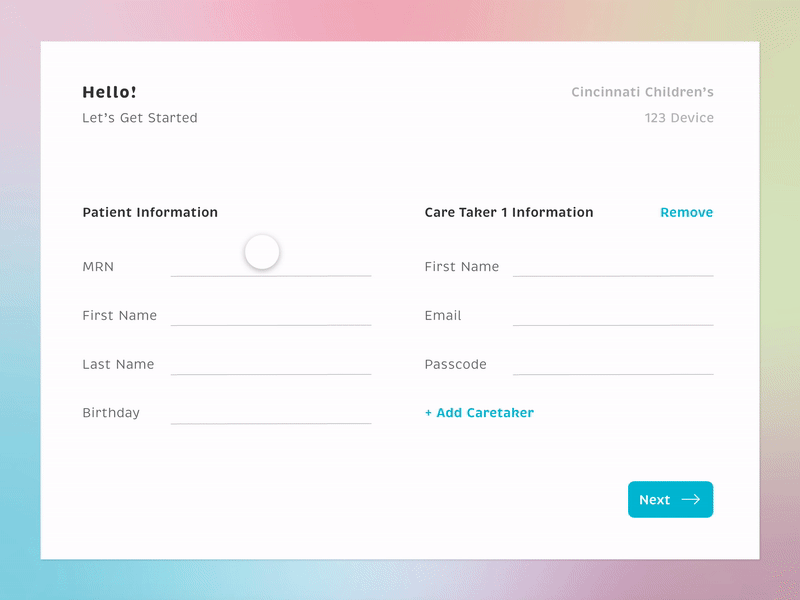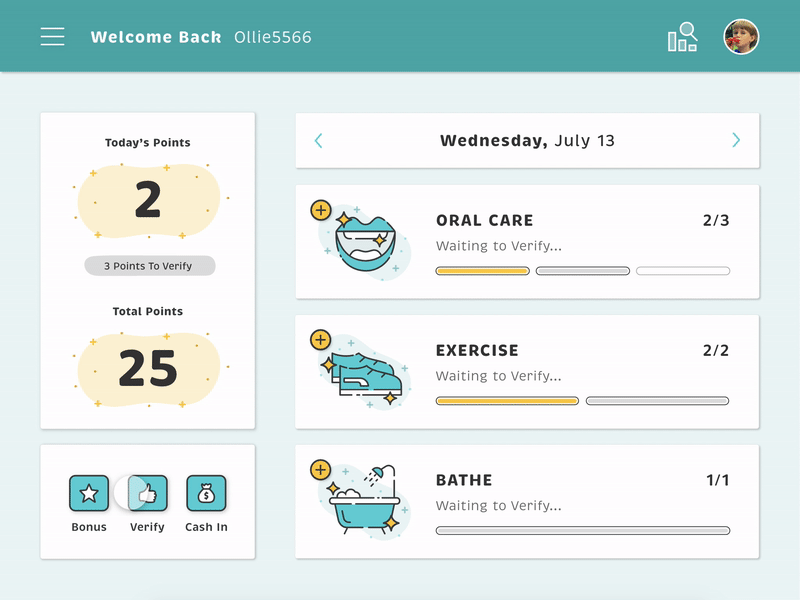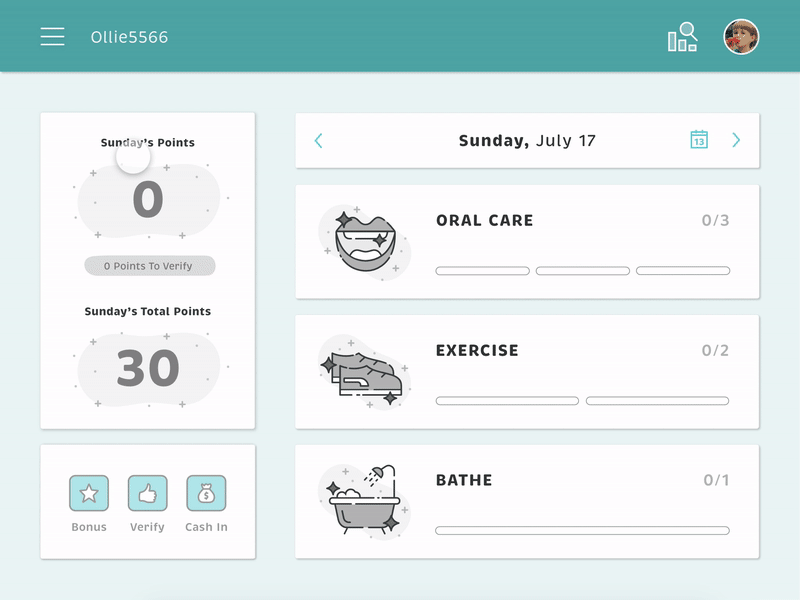SIMPLE FINANCE
Jan 2018-May 2018
SIMPLE FINANCE
Jan 2018-May 2018
SIMPLE FINANCE
Jan 2018-May 2018
SIMPLE FINANCE
Jan 2018-May 2018
SIMPLE FINANCE
Jan 2018-May 2018
1-2-3 Device Redesign
CLIENT
Cincinnati Children's Hospital: Cancer & Blood Diseases
MY ROLE
UX Design Fellow, Researcher, & UX/UI Design Lead
TIMELINE
May 2019 - April 2020

OVERVIEW
What Is The 1-2-3 Device?
The 1-2-3 initiative was developed in an effort to reduce infection rates and help patients manage their own physical activity and hygiene. This project was founded from a nurse-backed incentivized program that awarded stickers to patients who completed three activities of daily living (ADL’s). These ADL’s include bathing once, doing physical activity twice, and doing oral care three times hence the naming of the 1-2-3 Device. Stickers were exchanged for “BMT Bucks” which could be used to buy toys from Child Life.
The 1.0 device was developed to help automate this process for Bone Marrow Transplant (BMT) and Cancer/Blood Disease (CBDI) patients. Patients use the device to log these activities and keep track of points awarded for completion. RFID cards are swiped by patients for logging activities, and parents and nurses use their RFID cards to verify points.
OVERVIEW
1-2-3 Device 1.0 Version
The 1.0 device with family/caregiver RFID card before the redesign.

OVERVIEW
Defining The Problem
While the 1.0 device improved on overall patient adherence, it was difficult and time consuming for nurses to manage, lacked a deeper sense of patient motivation, was difficult to upkeep, and required more advanced functionality and hardware.
OVERVIEW
Project Goals

01
Understand experiential deficiencies of the 1.0 device and identify opportunities for improvement.

02
Develop a deeper understanding of what motivates patients to increase their compliance.

03
Design a V 2.0 with improved interaction, usability, and experience.
RESEARCH
Research Methods
A
Incentivization in Pediatrics
Goal: To better understand precedence and existing research on the relationships between incentivization, motivation, adherence, and/or habit-forming behavior
Methods: Literature Review
B
Investigating Relationship Between ADL Adherence and Bloodstream Infection, Prolonged Hospitalization, Pressure Ulcers and/or Therapy Schedules
Goal: To better understand cause/effect of ADL adherence
Methods: Analysis of historical data of BMT and Oncology patients ADL adherence
C
Education Program
Goal: To better understand the current educational program regarding Infection Prevention, ADLs, and Adherence
Methods: Collect and analyze existing material. Consider communication platform (“Infection Prevention Therapy”) Interviews with Healthcare Staff and Care Team memb
D
ADL Adherence Digital Application
Goal: Determine if/how a digital application could help certain co-producers improve ADL adherence
RESEARCH
In-depth Interviews
CCH Technical Leads
CCH Project Managers
CCH Clinical Research Coordinators
CCH Nurses
Patients & Parents/ Caregivers
RESEARCH
Insight Collection: Patients and/or Family Caregivers
Looking at what patient/caregiver motivators and barriers exist for each activity of daily living

RESEARCH
Insight Collection: Healthcare Professionals
Looking at what staff barriers exist for each activity of daily living

RESEARCH
1.0 Device Interaction Map
This map outlines every daily expected interaction with the 1.0 device as well as the pain points and opportunities areas for improvement. We learned that the 1.0 device requires far too much redundant interaction for nurses and families to maintain, which often left patients waiting for point gratification.

RESEARCH
Insight Collection: 1.0 Device Deficiencies
A
B
C
D
Nurse Workload
-
Nurses are often understaffed, work irregular hours, and extremely busy; making it difficult for them to remember to interact with the device and authorize points.
-
Nurses are more focused on procedure, so the device is considered low priority in their eyes.
Patient Motivation
-
With a wider range of ages admitted to the hospital (babies to 20’s), motivation differs greatly.
-
Being motivated by an extrinsic system of exchanging points for prizes is not actually very effective since patients are consistently getting toys during their stay anyway.
-
Interaction with the device is redundant with little immediate payoff.
System Upkeep
-
The prize management significantly increases workload for staff.
-
Swiping the RFID cards is burdensome due to cost, connection issues, and constant swiping.
Function & Hardware
-
Overtime, the interaction with the device loses its appeal and novelty, and becomes forgotten.
-
Parents and nursing staff are more concerned with the overall trend of how patients are performing rather than the day-to-day details.
-
No way to access any kind of data summary to track decline or improvement.
-
Current design limits adherence to only the three core activities.
-
Interface graphics require continual replacement due to constant disinfection.
IDEATION

Wireframing
IDEATION
User Testing: Draft 1
6 Users Tested
An avatar concept was originally proposed by nurses so it was well received when testing with staff; however when testing with older patients (teens), they felt it was too childish for them.
While younger children would use the avatar, we didn’t want to alienate older patients who could benefit from the device. The goal going into a second draft was to refine the less intuitive interactions and develop a new UI that appeals to a wider age range of ages.


IDEATION
User Testing: Draft 2
10 Users Tested
While overall usability was successful, there were mainly issues with the overall concept of verifying points. Nurses felt that being part of the verification process was unnecessary due to their already large workload.
We also discovered that not every child has a consistent family member to take part in validating points. Nurse and family members were mostly concerned about the patient’s overall adherence trend rather than day-to-day interactions.



REFINED DESIGN
Positive Reinforcement: Gamification of Activity Entry
REFINED DESIGN
Achievement UI: Trophy Case

REFINED DESIGN
Edit UI: Customizing & Editing Activities

REFINED DESIGN
Data Visualization UI: Progress Tracking

REFINED DESIGN
Mobile App UI: Remote Caregiver Access

My Role and Responsibilities
-
Formed project goals
-
Conducted stakeholder research
-
Developed personas
-
Identified device opportunities
-
Designed wireframes and information architecture
-
Independently developed the UI styles for the final designs
-
Led the design for the device interface and formatting of device UX
-
Independently led creation of Invision Studio interactive prototype
-
Conducted usability and research testing with nursing staff and patients Presented findings to key stakeholders and client directors
Key Learnings and Reflection
In this project I developed a deeper appreciation for the value of user testing. The target group consisted of children, parents, and nursing staff, so there was a wide range of ages, needs, and education levels to consider during the design process. Due to the variation of user conditions, it was important for me to let the testing results and feedback guide my design decisions. One example
of how user testing helped in developing a more valuable product was how the insights the team gathered from nurses became a big influence on the outcome of the data visualization. In the early stages of the project, I assumed nurses would want to be very involved and would appreciate a more detailed and comprehensive data history of the patient progress. However, after testing a few concepts with nurses, they expressed that they had very little time to interact with the device and they were more interested in visually obvious and quick to understand data feedback. Based on this information, I designed the data feedback screen to give nurses more of a data overview of where patients were succeeding or declining as well as a visualization of the progress trends for the week and month.
Project Team
Interface & Design
-
Ariel Swift: UX Design Fellow: Interface & Experience Design Lead (full-time 1 yr duration of project)
Research & Ideation
-
Ariel Swift: UX Design Fellow: Research & Ideation (full-time 1 yr duration of project)
-
Todd Timney: Faculty Research Fellow: Research & Ideation (full-time 1 yr duration of project)
-
Kellen Crosby: Biomedical Engineer Co-op: Research & Ideation (1 full-time & 2 part-time semesters)
-
Jay Hayne: Design Fellow: Research & Ideation(1 full-time semester)
